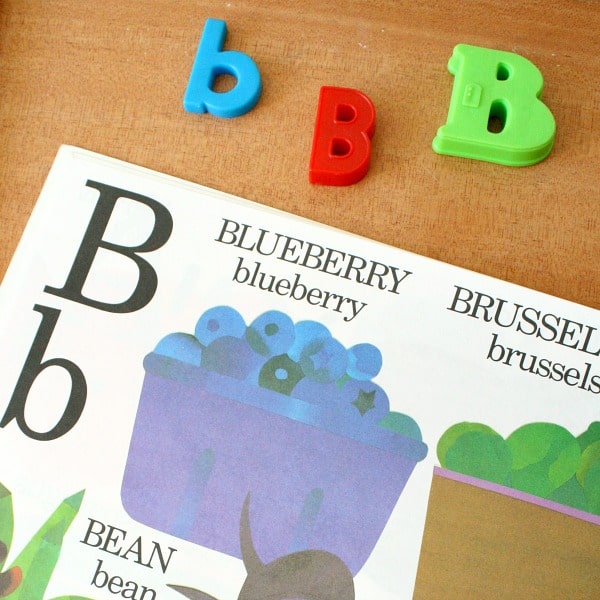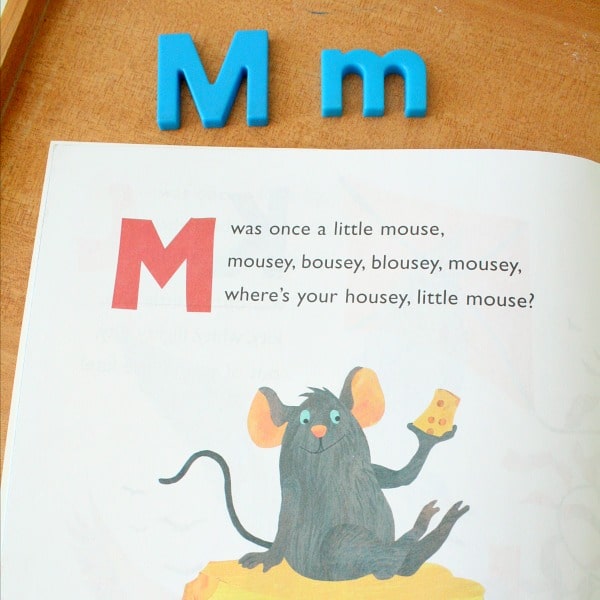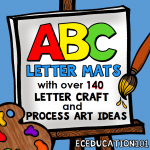Alphabet books are one of my go-to resources for introducing young children to the ABCs. There are a ton of great alphabet books to choose from, and they are very easy to find at local libraries and bookstores.
ABC books are also incredibly versatile, so you can use them to focus on a wide range of early literacy skills.
While ABC books are certainly a great way to teach the alphabet, there is SO much more that they can be used for….and they’re not just for preschoolers either!
Here we’ll explore some tips for using ABC books with babies, toddlers, preschoolers, and kindergarteners. You’ll also find some of our top picks for alphabet books to add to your bookshelves.

About ABC Books
Alphabet books are books that list each letter of the alphabet (most often in order from A to Z) with corresponding pictures or information.
Some books will list only the uppercase letters while others will list both the upper and lowercase.
ABC books for younger children most often include limited words on each page. The pictures often correspond with the common letter sound.
Other alphabet books can have longer descriptions and detailed information about the topic referenced by each letter. These books are often a fun way to explore topics with older children or children deeply interested in a specific topic.
Using ABC Books to Teach Babies and Toddlers
When reading with babies and toddlers the focus should not be on trying to teach the alphabet. Early exposure isn’t harmful, but rigorous practice is not necessary either. Instead focus on snuggling together and developing a positive association with reading and books.
Soft cloth or plastic books and board books are excellent for this age group. Allow kids to hold them, try to turn pages, and “read” on their own. Books with a touch and feel aspect are also wonderful for little ones.
The best alphabet books for babies and toddlers include a single letter or word and a bold, clear illustration or photograph.

When reading an ABC book with young kids they may lose interest part way through. That’s okay. Don’t push them to sit still and listen longer than their attention span allows. You can either set the book aside to finish later, or allow them to move about, color, or work on another quiet task as they listen to you finish reading the book aloud.
An excellent way to get the most of alphabet books with this age group is to choose ABC books that involve action or engagement of some sort by have kids move or respond along with the book.
Alphabet books that have a rhythm or rhyme for kids to focus in on will also help keep their attention. A You’re Adorable is one of our go-to ABC books that has been read over and over…and over again in our home over the years.

For babies and toddlers it is also helpful to choose ABC books that relate to common vocabulary. Kids can learn to name everyday items as they also get exposure to the alphabet.
Finally it can be a lot of fun to make your own family ABC book with little ones. It’s a fun way to use pictures and special family mementos to connect with your child. The Spruce has a terrific example for making one.
Using ABC Books to Teach Preschoolers and Kindergarteners
When reading alphabet books with preschoolers and kindergartners we shift more toward focusing on learning the alphabet.
Letter recognition is one of the key concepts most people rely on alphabet books for, and they are certainly a valuable tool for helping kids learn to recognize and name both upper and lowercase letters.
They are also excellent for helping little ones expand vocabulary. For this age group we often expand beyond naming everyday objects to more specific words and a wider variety of information.
ABC books are also wonderful for exploring concepts of print. With the common format for these books we can work on easily identifying the difference between a letter and a word as the letter is most often larger or bold. We can also help kids learn to count how many letters in a word to further reinforce the concept that words are made up of groups of letters.

When teaching with alphabet books we can also work on phonemic awareness and introduce the concept of beginning sounds. In Eat the Alphabet (pictured above) we see that there are many items listed for the letter B. Kids can identify each of the items and begin to notice the repetitive /b/ sound in each. As a follow up activity you can also choose a specific letter and brainstorm even more word that begin with the same sound.
Many ABC books also give us the opportunity to discuss phonological awareness skills. The bouncing rhyme in A Was Once an Apple Pie (pictured below) allows us to identify rhyming words while also examining the difference between real and nonsense words.

As kids get older that doesn’t mean we have to put away the alphabet books. Instead find one that encourage higher level thinking. Tomorrow’s Alphabet (pictured below) challenges kids to think about letters differently as they solve riddles for each letter. As they do so they have the opportunity to work on making inferences, an important skill for reading comprehension.

Alphabet books are also a helpful resource for content learning. Nonfiction ABC books can be used as first resources for early research projects. They often provide a wealth of information in a focused and easily digestible way for early learners. Jerry Pallotta’s alphabet books are some of our favorites for this purpose.
Below are collections of alphabet books on various topics we’ve explored on Fantastic Fun and Learning.
Learn about the Seasons
Learn about Favorite Topics
ABC Books about Transportation
Learn Geography and Social Studies
Explore America with ABC Books
Explore the World with ABC Books
Create Your Own Alphabet Books
Create your own alphabet books can be a wonderful way to explore topics in more details.
Education World has an excellent collection of ideas for creating alphabet books on a wide variety of topics.
In our ABC process art resource you’ll also find tons of ideas for process art and texture projects to use as you make your own ABC art book.
Find even more ideas for teaching the alphabet
Learn more about teaching the alphabet in our collection of hands-on alphabet activities and teaching tips.
More Alphabet Activities
Try these excellent resources for more hands-on alphabet activities.







Leave a Reply